Oratoire du Louvre
| Oratoire du Louvre | |
|---|---|
Temple protestant de l'Oratoire du Louvre | |
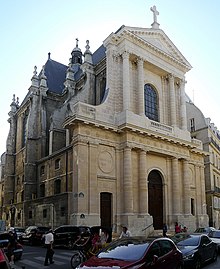 Front of the church from rue Saint-Honoré | |
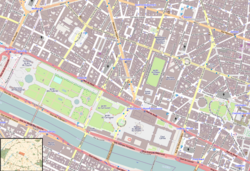 Oratoire du Louvre The location of l'Oratoire within Paris | |
| 48°51′42.7″N 2°20′25.1″E / 48.861861°N 2.340306°ECoordinates: 48°51′42.7″N 2°20′25.1″E / 48.861861°N 2.340306°E | |
| Location | Paris |
| Country | France |
| Denomination | United Protestant Church of France |
| Previous denomination | Reformed Church of France |
| Churchmanship | Liberal[1] |
| Website | oratoiredulouvre.fr |
| History | |
| Former name(s) | La congrégation de l'Oratoire de Jésus |
| Authorising papal bull | 1613 |
| Status | Parish church |
| Founded | November 1611 |
| Founder(s) | Pierre de Bérulle |
| Consecrated | July 12, 1750 |
| Events | Made royal chapel of the Louvre Palace by Louis XIII (1623); suppressed during the French Revolution (1792); Protestant church (1811) |
| Associated people | Louis XIII, Cardinal Richelieu, Anne of Austria, Paul-Henri Marron |
| Architecture | |
| Functional status | Active |
| Heritage designation | |
| Designated | 1907 |
| Architect(s) | Jacques Lemercier, Clément Métezeau, Pierre Caqué |
| Architectural type | Christian Church |
| Style | Baroque |
| Years built | 1621–1625, 1740–1745 |
| Groundbreaking | September 22, 1621 |
| Completed | 1745 |
| Administration | |
| Synod | Synode régional d'Île-de-France |
| Clergy | |
| Pastor(s) | Agnès Adeline-Schaeffer Béatrice Cléro-Mazire |
The Temple protestant de l'Oratoire du Louvre, also Église réformée de l'Oratoire du Louvre, is a historic Protestant church located at 145 rue Saint-Honoré – 160 rue de Rivoli in the 1st arrondissement of Paris, across the street from the Louvre. It was founded in 1611 by Pierre de Bérulle as the French branch of the Oratory of Saint Philip Neri. It was made the royal chapel of the Louvre Palace by Louis XIII on December 23, 1623, and was host to the funerals of both Louis and Cardinal Richelieu. Work on the church was suspended in 1625 and not resumed until 1740, with the church completed in 1745.
It was suppressed in 1792 during the French Revolution, looted, stripped of its decor, and used to store theater sets. In 1811, it was given by Napoleon to the Protestant congregation of Saint-Louis-du-Louvre when that building was demolished to make way for the expansion of the Louvre.[3] A statue and monument of Admiral Gaspard de Coligny, the great Huguenot leader of the 16th century, was built on the rue de Rivoli end of the church in 1889. It continues as one of the most prominent Reformed congregations in Paris, noted for its liberal theology.[4] The closest métro station is Louvre – Rivoli. ![]()
![]()
Prominent pastors[]
Gallery[]
- Interior

The pulpit and choir
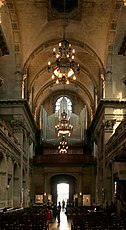
The nave and organ
Memorial to church members killed in World War I
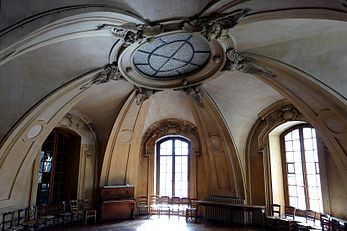
The upper room, onetime home to the American Church in Paris and later The Scots Kirk, Paris
Decoration that survived the French Revolution
- Exterior
The facade before restoration work, from rue Saint-Honoré
View of the church from Rue de Rivoli
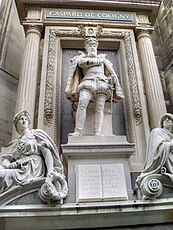
Statue of Gaspard de Coligny
References[]
- ^ "Bienvenue". L'Église Protestante Réformée de l'Oratoire du Louvre à Paris. Archived from the original on 2017-03-07. Retrieved 2015-04-14.
- ^ Base Mérimée: Temple de l'Oratoire du Louvre (ancienne chapelle du couvent de l'Oratoire), Ministère français de la Culture. (in French)
- ^ "The Temple de l'Oratoire". Musée protestant. Retrieved 2021-01-19.
- ^ "L'histoire de l'Oratoire". l'Oratoire du Louvre. Archived from the original on 2016-03-20. Retrieved 2015-04-14.
Sources[]
- Braunstein, Philippe (2011). L'Oratoire du Louvre et les protestants parisiens. Paris: Labor et Fides. ISBN 978-2830914320.
External links[]
| Wikimedia Commons has media related to Temple protestant de l'Oratoire du Louvre (Paris). |
- Official website (in French)
- Reformed churches in Paris
- Buildings and structures in the 1st arrondissement of Paris









